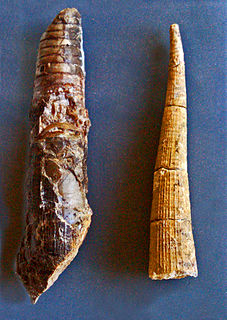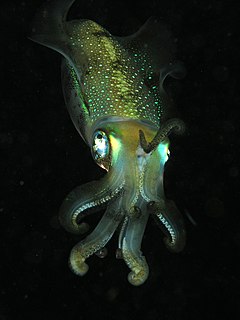The Ellesmerocerida is an order of primitive cephalopods belonging to the subclass Nautiloidea with a widespread distribution that lived during the Late Cambrian and Ordovician.
The Tarphycerida were the first of the coiled cephalopods, found in marine sediments from the Lower Ordovician to the Middle Devonian. Some, such as Aphetoceras and Estonioceras, are loosely coiled and gyroconic; others, such as Campbelloceras, Tarphyceras, and Trocholites, are tightly coiled, but evolute with all whorls showing. The body chamber of tarphycerids is typically long and tubular, as much as half the length of the containing whorl in most, greater than in the Silurian Ophidioceratidae. The Tarphycerida evolved from the elongated, compressed, exogastric Bassleroceratidae, probably Bassleroceras, around the end of the Gasconadian through forms like Aphetoceras. Close coiling developed rather quickly, and both gyroconic and evolute forms are found in the early middle Canadian.
The Lowoceratidae is a small family of discosorids, early nautiloid cephalopods, from the Middle Silurian in which the characteristic bullette is found only in early growth stages. Lowoceratids were first found in Southampton Island in the Canadian arctic.
Paraloxoceras is a genus of straight shelled, orthoconic nautiloid cephalopods, now extinct, that lived during the Early Carboniferous. Fossils have been found in Europe and central Asia; the type, P. konincki, named by Flower, came from Belgium.
Jovellania is a genus of extinct prehistoric nautiloids from the order Oncocerida known from the Lower Devonian of Europe. Nautiloids form a broad group of shelled cephalopods that were once diverse and numerous but are now represented by only a handful of species in two genera.

Kionoceras is an extinct nautiloid cephalopod genus included in the orthocerid family Kionoceratidae with scattered worldwide distribution from the Middle Ordovician to the Lower Permian. Kionoceratids are orthocerids with prominent longitudinal ornamentation on their shells, sometimes augmented by secondary transverse ornamenttion. Orthocerids are, of course, prehistoric nautiloides with generally straight and elongate shells, mostly with central or subcentral siphuncles.
Hoeloceras is an extinct orthoconic nautiloid cephalopod from the upper Ordovician, generally included in the Actinocerida. Nautiloids are a subclass of shelled cephalopods that were once diverse and numerous but are now represented by only a couple of genera, Nautilus and Allonautilus.
Winnipegoceras is an extinct nautiloid genus from the Ordovician belonging to the Order Discosorida.
Ulrichoceras is recognised as the basal cyrtogomphoceratid genus, which is the source for the rest of the Cyrtogomphoceratidae as well as for the Westonoceratidae. The Cyrtogomphoceratidae are endogastric, the Westonoceratidae, exogastric.
Tetrapleuroceras is an extinct prehistoric nautiloid from the Lower Permian of the Urals in Russia. Nautilids are a type of nautiloid, a subclass of shelled cephalopods that were once diverse and numerous but now only represented by Nautilus and Allonautilus
Westonoceras is an extinct nautiloid genus from the Discosorida that lived during the Middle and Late Ordovician that has been found in North America, Greenland, and Northern Europe. It is the type genus for the Westonoceratidae
Stearoceras is an extinct genus of prehistoric nautiloids from the Lower Pennsylvanian - Lower Permian with a fair worldwide distribution.(Kümmel 1964)

The Phragmoceratidae is a family of extinct nautiloid cephalopods from the Order Discosorida that lived during the latter part of the Silurian.
Mandaloceratidae is a family in the nautiloid cephalopod order Discosorida, from the Middle and Upper(?) Silurian characterized by short, essentially straight shells referred to as breviconic, typically with a faintly exogastric shape produced by the profile of the body chamber. Apertures vary from round to T-shaped, with a long narrow, ventral, hyponomic sinus for the maneuvering funnel. Siphuncles are commonly central or subcentral with generally broad, expanded, segments and usually thin connecting rings.
The Cyrtogomphoceratidae are a family in the cephalopod order Discosorida that comprises genera commonly with compressed, endogastrically curved shells. Siphuncles lie close to the ventral side, segments are broadly inflated, connecting rings thick and apically expanded thick bullettes. Chambers are short, separated by shallow, dish shaped septa. Apertures are generally simple.
Teichertoceras is a discosorid genus in the family Westonoceratidae characterized by an endogastric curvature to the early portion of the phragmocone.
Jaregoceras is a genus of nautiloids from the Upper Devonian discosorid that probably belongs to the family Discosoridae.

Lorieroceras lorieri is an extinct oncocerid nautilitoidean cephalopod belonging to the family Nothoceratidae. Fossils are found in Lower Devonian marine strata of France. Its shell is unusual among nautiloids in that it is a loosely coiled, turban-shaped helix that is sinistrally coiled.




